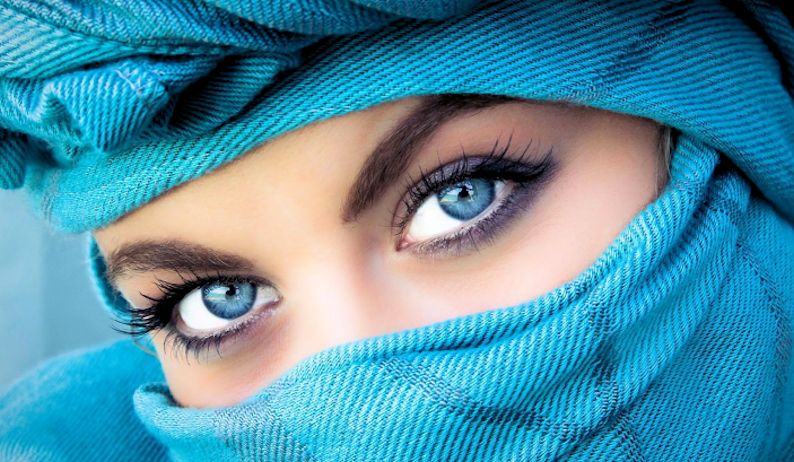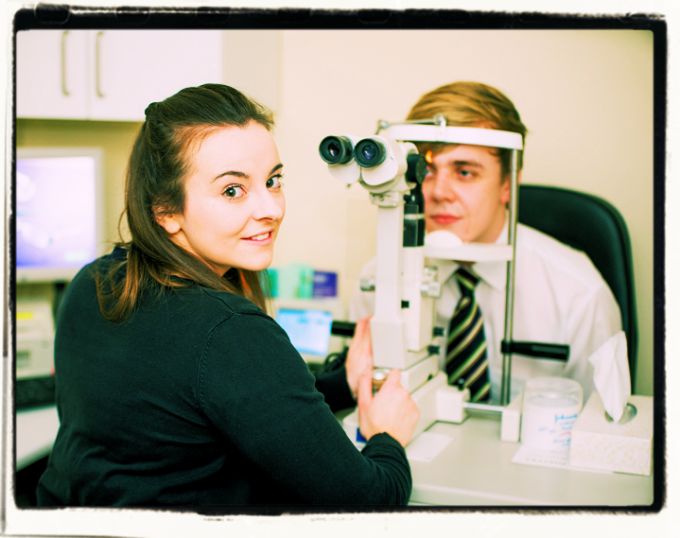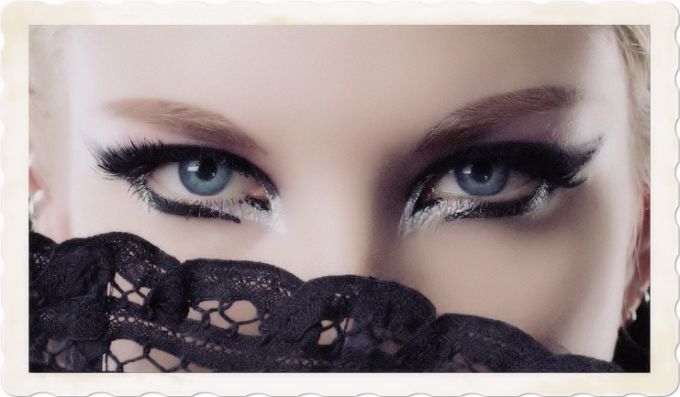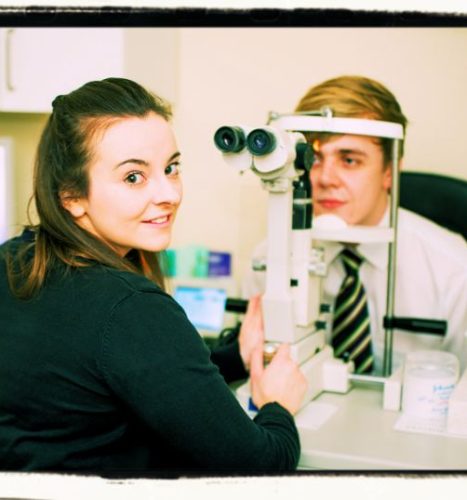
Questions and topics about opticians and optical colleges, the world of sight, eye and vision. Useful material for students and teachers.
1) What is the function of the eye?
The eye is the photoreceptive sense organ through which people acquire knowledge of the world around themselves. The human beings, the information provided by their eyes plays a basic role in the interpretation of the environment. In fact, seeing is also understanding and understanding depends on the way light sensitive receptive cells are connected with the central nervous system which is part of the brain. The ability to perceive objects, colours and distances is acquired by experience.
2) What is a microscope?
It is an instrument for magnifying small objects by means of a lens or lenses so as to reveal details invisible to the naked eye. there are several sets of lenses in the microscope. We can have also an electronic microscope, that uses electrons as the light source and has a magnification power of one million which is much higher than a conventional optical microscope that functions with ordinary light.
3) What does the orbit contain?
The orbit, the bony cavity in the skull, contains the eyeball, muscles, lacrimal glands, the blood vessels and nerves. The remaining space within the orbit is filled with a fatty pad that permits smooth and free movements of the globe. The orbit is also designed to protect the eye from injuries.
4) What is the function of the fatty pad? (See 3)
5) What is the orbit composed of?
The orbit is made up of portions of the bones of the skull. These bones form a pyramid whose apex points back into the head. 8portions of the maxilla, zygomatic and palatine bones for the bottom of the orbit; over these the orbit consists of the orbital plate of the frontal bone. Behind the frontal bone, we find the sphenoid bone. It is butterfly shaped forming the front part of the base of the skull and portions of the cranial, orbital and nasal cavities.
6) What is the eye composed of?
The eye is the organ of sight; it is composed of the eyeball and other parts.
7) What is the eyeball composed of?
The eyeball is made up of three different membranes: sclera, choroid and retina.
8) What are the membranes of the eyeball made up of?
The sclera is a layer of dense white tissue; choroid tissue is coloured brown or black and contains bloood vessels; the retina is a thin layer of light sensitive cells.
9) What is the sclera?
It is a layer of dense white tissue; it is also called sclerotic coat.
10) Where does the choroid tissue lie?
Choroid tissue lies beneath more than 2/3 of the sclera.
11) Which are the other parts of the eye?
The other parts of the eye are: the muscles, protective structures and lacrimal apparatus.
12) What do ciliary muscles control?
Ciliary muscles control the shape of the lens. If they contract the lens is stretched and light rays from long distances are focused on the retina. On the contrary, if they relax, light rays are focused on the retina from close distances.
13) What are the protective structures of the eye?
The protective structures are: eyelids, eyelashes, eyebrows, lacrimal ducts, lacrimal glands and blinking.
14) Where does the lacrimal fluid flow and what is its function?
It is produced by the lacrimal glands and then it flows into the nasal cavity through lacrimal canal. It serves to keep the external surface of the eyeball wet.
15) What is the cornea?
The cornea is the transparent anterior portion of the outer coating covering the iris and the pupil.
16) What does the cornea cover?
The cornea covers the iris and the pupil.
17) Is our vision affected by defects of the cornea?
The cornea is the eye’s most important refractive surface, it acts like a clear window, so that any scar, defect or irregularity in the cornea has a seriuos effect on vision.
18) What does the cornea consist of?
The cornea consists of nerve fibres which are very sensitive to pain. Such sensitivity is the reason why any corneal disease is always painful.

19) What is the action of tears and what are they made of?
Tears have a protective action on the cornea, an extremely delicate part of the eye and they are made of a saltery watery fluid.
20) What does the cornea absorb fluid from?
About 90% of the thickness of the cornea is made up of the stroma. The stroma is a supporting tissue made up of a series of lamellae superimposed like the layer of an onion. under normal conditions, the cornea tends to absorb liquid especially from the aqueous humor and the blood vessels but, at the same time, a pump expels the fluid as fast as it enters. This is the result of an adequate energy supply. When there is a lack of this energy, the pump stops working or it works slowly and the cornea swells. Death and its consequent decreasing of the bloody temperature is one cause of the failure of this pumping action.
21) Why must the cornea be kept warm in transplant cases?
A corneal transplant requires placing of the dead eye in a warm chamber so that the reserve of metabolic energy it contains, will keep the cornea transparent for 24 hours or more.
22) What is the normal temperature of the cornea?
To expel fluid and resume its previous transparency, the cornea must be kept at about 31° C, which is its normal temperature.
23) What is the retina?
The retina is a thin layer of light sensitive cells; they are classified by shape: rods and cones.
24) What is its function?
The retina has the function of receiving light and turning it into chemical energy. Such chemical energy allows the nerves to bring the message from the eye to the higher regions of the brain.
25) What are the cells of the retina called?
They are called rods and cones.
26) What is the field of vision?
It is the area that can be seen by an eye without moving it. The amplitude of the field varies with different colours: “white” is the largest than yellow, blue, red and green.
27) What are the principal defects of sight?
An eye is said to be emmetrope when it works properly. Sometimes it has defects connected with focusing or diseases connected with the lens, the sensibility of receptors or the shape of the cornea. The most common defects are:
– nearsightedness (myopia) is due to the eye’s refractive power being too strong or to the eyeball being too long. In both conditions the light rays are focused in front of the retina giving a confused image. Concave corrective lenses are needed to focus on distant objects;
– Farsightdness (hypermetropia) is caused by the eye’s refractive power being too weak or by the eyeball being too short. In both conditions light rays are focused behind the retina giving a confused image. Convex corrective lenses are needed to get good focus on close objects;
– Astigmatism means that a person cannot focus on the main meridians at the same time because the cornea doesn’t curve correctly.
lenses, affecting the light rays on one of the planes, are required; hard contact lenses are suggested;
– Presbyopia is common in old age. It consists of a reduced ability to focus the eye on near objects because of a gradual loss of elasticity of the cristalline
– Daltonism means colour blindness for some colours.
28) What are the main eye diseases?
Generally speaking, an eye disease occurs when there is something wrong with the sensibility of the receptors, the lens and the cornea. The most common diseases of the eye are:
– black eyes are bruises of the eyelids and the tissue around the eye; it can be cured by applying a cold compress;
– a stye is an inflammated swelling of the edge of the eyelid and it is caused by bacterial infection;
– conjunctivitis is an inflammation of the conjunctiva (the membrane covering the front of th eyeball and the inside of the eyelids). It can be caused by infection or irritation and is due to bacterial or viral infection. It is not a very serious disease in itself but sometimes it can damage the cornea ( the clear part of the eyeball);
– blepharitis is an inflammation of the eyelid margin. It can be “mild” and consists of redness of the eyelid margin or it can be more severe, affecting the follicles of the eyelashes.
– herpes Zoster (shingles) affects the skin of the eyelids and it can be severe when it affects the cornea and the inner eye.
-glaucoma: is due to an increase in ocular tension or to some atrophy of the pupil involving gradual loss of field of vision.
– keratoconous is a developmental anomaly where the central portion of the cornea becomes progressively thinner as a displaced and increasing protrusion.
Beginning in one eye but later affecting both, it usually manifests itself t puberty.
29) What are the main eye disorders?
Their symptoms are: blindness, temporary diminished eyesight, impaired vision. We can have blurred vision, that is a loss of visual acuity resulting in unclear visual details; vision loss: that is the inability to perceive visual stimuli; blind spots: that is apparent dark holes in the visual field in which nothing can be seen.
30) What are the main causes of eye disorders?
They are: aging, the most common cause of decreased vision; cataracts, also common in the elderly; glaucoma, a disease of the eye characterised by increased fluid pressure within the eyeball; complications of diabetes, one of the most common causes of blindness; retinal haemorrhages which can cause more permanent blindness diabetic retinopathy.
31) Which professional should you consult in the event of a loss of visual acuity? Decreased vision is a significant threat to the quality of life. Professional help is always a good idea, but which professional to see is often a dilemma. Opticians, Optometrists, Opthalmologist, are professional people who take care of the human eye. Although they work in the same field, that is to say “Oculistic”, their tasks differ. An Optician dispenses glasses and doesn’t diagnose eye problems. An Optometrist is a doctor of optometry specialised in evaluating the need for glasses and decides what type of lens will provide the best vision. An optometrist can diagnose and treat many eye defects, although in some countries they can also diagnose and treat other medical problems. An Opthalmologist is a physician specialised in eye disorders and is the appropriate person to consult for diseases of the eye. In any case you must keep in mind that sometimes an eye problem is part of a general health problem, that’s why general professional help may be appropriate. (vision correction, I need glasses, I am short-sighted, special glasses, frames, lenses, etc.
32) What are lenses usually made of and what kind of lenses can we have? Manufactured lenses are usally made of glass, but we can they can also be made by transparent plastic. Lenses are classified by the curvature of the two optical surfaces. (A lens is an optical device with perfect or approximate axial symmetry which transmits and refracts light, converging or diverging the beam.) Lenses, made of solid pieces of glass, must be highly polished and blank lenses are then worked into the desired shape, the shape is obtained by a wheel rotating at high speed and containing a special grinding device which doesn’t damage the glass. We can have concave, biconcave, convex, biconvex, and convex concave lenses.
33) What kind of lenses and glasses must we use to correct the different kind of refractive errors of the eye?
Eyeglass lenses correct refractive errors by focusing light directly on the retina. The type of lens depends on the type and severity of the refractive error.
The strength of a lens (i.e., its refractive power) is measured in optical units called diopters. This measurement indicates how much refractive power the lens must have to focus images directly on the retina. The higher the diopter, the stronger the lens.
The type of refractive error determines the lens’s shape. A concave (minus) lens is used to correct myopia (nearsightedness). In myopia, light rays fall in front of the retina rather than on it. Because a concave lens is thin in the center and thicker on the edges, it diverges (spreads out) light rays so that the eye’s lens focuses them directly on the retina.
A convex (plus) lens is used to correct hyperopia (farsightedness). In hyperopia, light rays fall behind the retina. The lens is thickest in the center and thinnest on the outer edges. The convex lens converges (concentrates) light rays so that the eye’s lens focuses them on the retina.
To correct astigmatism, which is caused by distortions in the shape of the lens or cornea, a cylinder lens is frequently used. The cylinder lens has two refractive powers on one lens. One power is placed over the entire lens and the other is oriented in one direction. This corrects the scattered pattern in which light enters the eye and creates one focal point on the retina.
Multifocal Lenses
People that have more than one refractive error may require two pairs of eyeglasses or glasses with multifocal lenses. Multifocal lenses contain two or more vision-correcting prescriptions.
Bifocals are the most common type of multifocal lenses. The lens is split in two sections; the upper part is for distance vision and the lower part for near vision. They are usually prescribed for people over the age of 40 whose focusing ability has declined due to presbyopia.
Trifocals have a third section used for middle distance vision (i.e., objects within arm?s reach, such as a computer screen).
Progressive lenses are sometimes referred to as “no-line” bifocals because there is no noticeable line dividing the different prescriptions. There is a continuous change in magnification from the distance, or upper, portion of the lens, to the near, or lower, portion of the lens. They therefore provide a smoother transition between distance and near vision that some feel is closer to natural vision than other multifocal lenses. However, not everyone adapts well to them.
34) What are the most common material employed to manufacture glasses frames? The choice of frames usually depends on personal preference, fashion, comfort, and cost. Frames are made from metals, plastic, nylon, and other synthetics. Each material has its advantages. Pure titanium, for example, is lightweight, strong, and durable and frames made from titanium are very light, long lasting, and hypoallergenic. They are also expensive. A titanium alloy called Flexon, or the “memory metal,” has recently been developed. Flexon frames return to their original shape after being damaged or bent. This metal is very light and resists corrosion.
35) What is the funcion of contact lenses and what kind of contact lenses can we find on the market? Eyeglasses and contact lenses correct the action of the defective part of the eye. Contact lenses are thin round disks made of plastic, placed on the surface of the eye. They require more care than glasses as they need to be cleaned and stored in a special fluid when not being worn, what’s more some people can’t wear them at all. Two types of contact lenses are available on the market, hard and soft. With regard to hard ones, they can be scleral (covering the visible part of the eye) and corneal (covering the central part of the eye). Corneal lenses are more commonly used than the scleral type, but scleral lenses are worn especially for sporting activites. On the other hand soft lenses are more comfortable, easier to manage and can be worn for many hours on end without any problems. They are however more expensive than hard contact lenses.
36) What is a measurements lensmeter? It is an optical instrument that allows the measurement of the lens power. As a matter of fact one of the most important functions in the handling opthalmic lenses, from production to the final inspection of the completed prescription, is the measurement of lens power.

37) What is the function of an Ophthalmic instruments, such as the Condor Compact? It is an instrument that permits performing simple and efficient fundus camera examinations of the eye and of the retina, through it you can take pictures of the fundus, you can zoom to see better images of the eye fundus, and you can save images of it on a computer connected to the instrument.
38) Nowadays, what do opticians complain about? Opticians have been complaining that non professional sales points are taking the sunglasses business away from the optical trade. An opticians to understand the trend of the selling market must be kept informed, attending fashion shows, reading newspapers and magazines, and watching commercial on tv. The media leads the demand and people look for the kind of glasses the see advertised or worn by others. This is especially true for the young. By keeping informed, one can enter the ypoung customer’s mind.
39) What must you do if you want to find a job? To apply for it, read the work advertisments in the newspsapers or on the web, write a curriculum vitae and send it to specialized optical shops or firms.
40) What are the main points to include in a curriculum vitae? The Curriculum Vitae is an outline of a person’s educational and professional history, usually prepared for job applications (L, lit.: the course of one’s life). A CV is the most flexible and convenient way to make applications. It conveys your personal details in the way that presents you in the best possible light and can be used to make multiple applications to employers in a specific career area. For this reason, many large graduate recruiters will not accept CVs and instead use their own application form. An application form is designed to bring out the essential information and personal qualities that the employer requires and does not allow you to gloss over your weaker points as a CV does. In addition, the time needed to fill out these forms is seen as a reflection of your commitment to the career.
What information should a CV include?
Personal details
Normally these would be your name, address, date of birth (although with age discrimination laws now in force this isn’t essential), telephone number and email.
Education and qualifications
Your degree subject and university, plus A levels and GCSEs or equivalents. Mention grades unless poor!
Work experience
Use action words such as developed, planned and organised.
Even work in a shop, bar or restaurant will involve working in a team, providing a quality service to customers, and dealing tactfully with complaints. Don’t mention the routine, non-people tasks (cleaning the tables) unless you are applying for a casual summer job in a restaurant or similar.
Try to relate the skills to the job. A finance job will involve numeracy, analytical and problem solving skills so focus on these whereas for a marketing role you would place a bit more more emphasis on persuading and negotiating skills.
Interests and achievements
Keep this section short and to the point. As you grow older, your employment record will take precedence and interests will typically diminish greatly in length and importance.
Bullets can be used to separate interests into different types: sporting, creative etc.
Don’t use the old boring cliches here: “socialising with friends”.
Don’t put many passive, solitary hobbies (reading, watching TV, stamp collecting) or you may be perceived as lacking people skills.
Show a range of interests to avoid coming across as narrow : if everything centres around sport they may wonder if you could hold a conversation with a client who wasn’t interested in sport.
Hobbies that are a little out of the ordinary can help you to stand out from the crowd: skydiving or mountaineering can show a sense of wanting to stretch yourself and an ability to rely on yourself in demanding situations
Any interests relevant to the job are worth mentioning: current affairs if you wish to be a journalist; a fantasy share portfolio such as Bullbearings if you want to work in finance.
Any evidence of leadership is important to mention: captain or coach of a sports team, course representative, chair of a student society, scout leader.
Anything showing evidence of employability skills such as teamworking, organising, planning, persuading, negotiating etc.
Skills
The usual ones to mention are languages (good conversational French, basic Spanish), computing (e.g. “good working knowledge of MS Access and Excel, plus basic web page design skills” and driving (“full current clean driving license”).
If you are a mature candidate or have lots of relevant skills to offer, a skills-based CV may work for you
Referees
Normally two referees are sufficient: one academic (perhaps your tutor or a project supervisor) and one from an employer (perhaps your last part-time or summer job). See our page on Choosing and Using Referees for more help with this.
Notes:
I have been suffering from myopia for some time and I started to feel tired of wearing glasses. I want to change my outlook and I would like to get rid of my glasses. I heard that wearing orthokeratology lens correct myopia. My mother is against it since she is afraid I could hurt my eyes while wearing lenses during the night. Can orthokeratology lens correct my myopia?
Hello! Orthokeratology lenses are one of the possibilities to reduce the wearing of your eye glasses. But, as I know their results in serious decreasing of myopia degrees in adults have been disappointing. As I know the procedure appears to retard a little the progression of myopia in children with early myopia. It also works the best up to 4,00 diopters of myopia and I know it is very safe. The development of effective methods for preventing and correcting myopia in pilots is one of the most important problems of aeronautic ophthalmology. The majority of Russian and foreign aeronautic ophthalmologists agree that contact correction is the principal method for repair of occupational vision of myopic pilots. Experiments with soft contact lenses with 38 and 70% humor content were carried out. The methodology was based on comprehensive examinations of the vision status and status of the organ of vision under common conditions on the Earth and during simulation of unfavorable flight factors. The results indicate that contact lenses are a safe means for correcting myopia in pilots. This is confirmed by the absence of unfavorable changes in the main visual functions and in the status of the anterior segment of the eye, by a constant level of visual working capacity, and by the absence of negative subjective sensations.
You can also download these PDF files:
Questions and topics about Opticians and Optical Colleges

